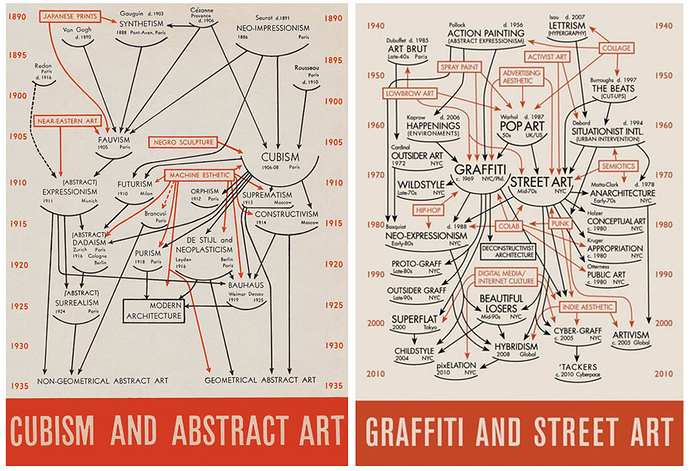I could be wrong, but I doubt there is a name for it beyond just calling it silhouette art.
Most artists develop styles that emerge from things that interest them.They will try something, which leads to something else, which gets incorporated into something they’ve seen that inspires them, which spawns a new idea and, over time, repeating this process and by heading down different roads and trying different things, new looks and ways of doing thing develop that becomes those artists’ styles.
These styles rarely have names unless they really catch on and lots of people start incorporating them into their own works.
That is a completely awesome image. Wow…
Fundamentally it is known as fragmentation.
I’ve always called it a Monochromatic Silhouette Illustration. I looked her up on Shutterstock and then went down the rabbit trail … the common tag in all designs like this is Silhouette.
I imagine that there are rare cases where someone is impressed by someone else knowing the popular name of a style. It might be useful in an art history class. But I really don’t think knowing popular names of styles matters much these days. My answer to almost every one of these types of threads asking for style names is “whatever you want to call it.” Then you can catalog it in your memory bank of things you might want to refer back to when you hit a creative block. Or you could just remember the combination of techniques and what you liked about the combination.
On that logic … how would we communicate in a succinct and meaningful manner?
Futurism
Modernism
Constructivism
etc., etc., etc…
Fragmentation
Names matter, they have way of cutting straight through the endless yaddi yaddi yaddi of the personal blah blah blahs.
BTW, I’m not saying that the yaddi yaddi yaddi blah blah blahs are invalid.
k?
By describing the technique, not by repeating the (stated or assumed) communication goals or style name from the artist who originated the combination of techniques
Action Painters … also known as the New York School of the mid 20th century … have very similar characteristics of expression as that of 500 hundred years earlier of the great Japanese artist Sesshu.
The informal techniques are very similar.
The names matter because of their placement, not only in time … but also where in the world this technique was being employed …and also the ‘environment’ in which they were employed.
New York School … think Pollack, Motherwell, Kline etc., Americans employing almost the exact same technique but with an distinctly American ‘flare’ as that of 500 hundred years earlier by Sesshu Toyo in Japan.
Names matter.
Other examples?
Rinpa School
Dada
Graffiti
You get the idea …techniques are a means of expression and that expression is locked in time and place. To me, that is what really matters. The when, where of it all and who done did it!
For instance, how the European art scene of Impressionism and Post-Impressionism was totally impacted by the amazing artists of Japanese Ukiyo-e!
And I’m not even going to dive into deep waters of Graffiti and all the styles thereof … nope.
Placement in time can be just as easily defined by the name of political movements as they can be by artistic style. To a historian, the political movements are much more relevant. The name of styles matter not. Most of the criteria for defining styles and genres are built on shifting sands. It reminds me of the days in the 1970s when Soul music had a race-based criteria for identifying a sound.
Now we are entering an age of A.I. algorithms looking for patterns and consistency in images and sounds. Eventually they will be more consistent in finding patterns than humans. I doubt those patterns will be identified by names.
This supports my point that it doesn’t matter. A technique is a technique regardless of the time period.
I’m going to disagree a bit here. There are only superficial visual similarities between some of Sesshu Toyo’s looser works and the action painters.
The action painters were known for finally making a break with subject matter, while sometimes claiming their art was in the action of creating their work. The final pieces were sometimes described as merely records of the art having taken place.
Sesshu Toyo, despite the looseness of brush strokes in of some of his work, never, as far as I know, made the philosophical break of giving up the pretense of portraying subject matter, and he never made any of the philosophical claims about his work being merely a record of his art having taken place.
You’re conflating totally different styles that emerged from totally different cultural contexts and that have only passing and coincidental similarities.
I’ve never heard of “Fragmentation” art. The work in question looks like stylized silhouettes to me. A couple of quick Google searches didn’t turn up much of anything either. Can you point to something about this, so I can read up on it.
People have a tendency to categorize, even to the point of arbitrarily drawing lines that don’t logically or naturally exist. It’s fine when boundaries actually occur that make labeling useful, but it gets in the way when artificial categories are imposed upon a spectrum that has no clear breaks between one thing and the next.
When categorization and labeling is applied to art, it’s useful when describing, say, Impressionism, Cubism, Fauvism, Dada and other art movements because those movements were fairly distinct and broadly based. But at what point does Dada stop and Surrealism begin? At what point does Surrealism end and Abstract Expressionism pick up?
What I’m trying to say is that, yes, “names matter” sometimes — especially when they clarify and provide focus. Other times, however, they get in the way by imposing artificial and non-existent distinctions in a continuum of grays.
Sorry Mr. B, but that’s just another example of superficial thinking … and at worst a complete ignorance (for whatever reason(s)) of the amazing lineage of art concepts & theories.
It’s is the absolute break from the confines of tradition which Sesshu Toyo was demonstrating … and NOT …repeat NOT … his subject matter.
Subject is meaningless … it is only a ‘vehicle’ to carry a methodology.
Sesshu’s technique was clearly demonstrating a freedom of how ink can be deployed. The subjects he chose were practically irrelevant.
So, when you erroneously view an art work only on it’s surface you ultimately limit your natural abilities to understand what is truly being said …and done.
Art fragmentation effect …
http://lmgtfy.com/?q=art+fragmentation+effect
Once again … superficial thinking. Instead, look deeper into the history of art and remember … one thing leads to another. No school, manifesto or any declaration of independence happens in a vacuum. Perhaps you’ve seen this classic example …
On the left …
Jacket for the catalogue Cubism and Abstract Art, 1936, with a chart of modernist art history by Alfred H. Barr, Jr.
On the right…
Some riff by an unknown.
…glad to help!
Fractal geometry … is a name … and it’s already been done.
Thanks for proving my point!
The real sadness comes with the negelect of those who have come before. Ultimately, there is a family tree of names, of doctrines, of schools, of manifestos, etc., which can all be traced back. Many, many use similar techniques!
I’m not saying techniques are irrelevant. What I am saying is that techniques are a method to express art …informal or formal doesn’t matter. And those techniques will come and go and come again only in different interpretations!
BTW, that is the definition of genius.
Grfkdzgn, I had already Googled your fragmentation style claim and came up with nothing but an assortment of fragmented images. Fragmentation is a description of anything that’s fragmented — which is not the same as an art style or movement.
Using your same Googling technique of combining nouns and verbs with the word effect, one could come up with endless arrays of results sharing various similarities. The returns from these kinds of Google searches are not necessarily the same as art styles or movements. And as far as I can tell, no art style exists called “fragmentation.”
I have already seen plenty of graphics of the kind you posted that connect one category of thing to another. They actually demonstrate my point about artificially imposing boundaries upon nebulous connections where one thing gradually transitions into another. Most of the space ends up being the connections between the categories.
As for Sesshu Toyo, his work was innovative but still firmly rooted in Japanese tradition. As I said, Sesshu’s work has only superficial and occasional stylistic similarities to the action painters. Many much stronger and more direct connections exist between Japanese 19th Century Western art, like Van Gogh’s or Degas’ fascination with Japanese woodblock prints.
It seems we are talking past each other, or you are missing my point altogether.
Fractal geometry is a technique regardless of what it’s named. If you named it something different, the technique would remain the same. Again, names don’t matter. It’s about as important as a celestial navigator knowing the Greek mythological names of stars in order to follow them. They only need recognize the patterns. Yes, centuries ago, those names (and associated stories) help them remember the patterns. Today those names are meaningless with all the technology we have for celestial navigation and all the tools we have for externalizing our memory. Theoretically, at some point, we won’t need to remember anything other than how to access our memory devices.
If an A.I. program discovered how to make fractal geometrical patterns, it wouldn’t necessarily name it “fractal geometry.” It’s most likely to name it “10101010111011001110111” or something of the sort. And that name would only be used for it’s own internal memory recall purposes.
Actually, these are the top three definitions from dictionary.com.
“an exceptional natural capacity of intellect, especially as shown in creative and original work in science, art, music, etc.”
“a person having such capacity.”
“a person having an extraordinarily high intelligence rating on a psychological test, as an IQ above 140.”
Thanks for the info. I think fragmentation probably works best for me. Although it does inspire an image more along the lines of something being pixelated, in my mind. I just like to know what I should call thinks during discussion
I do not know the meaning of this genre, but many artists combine it into their own work.
Seemms like…

